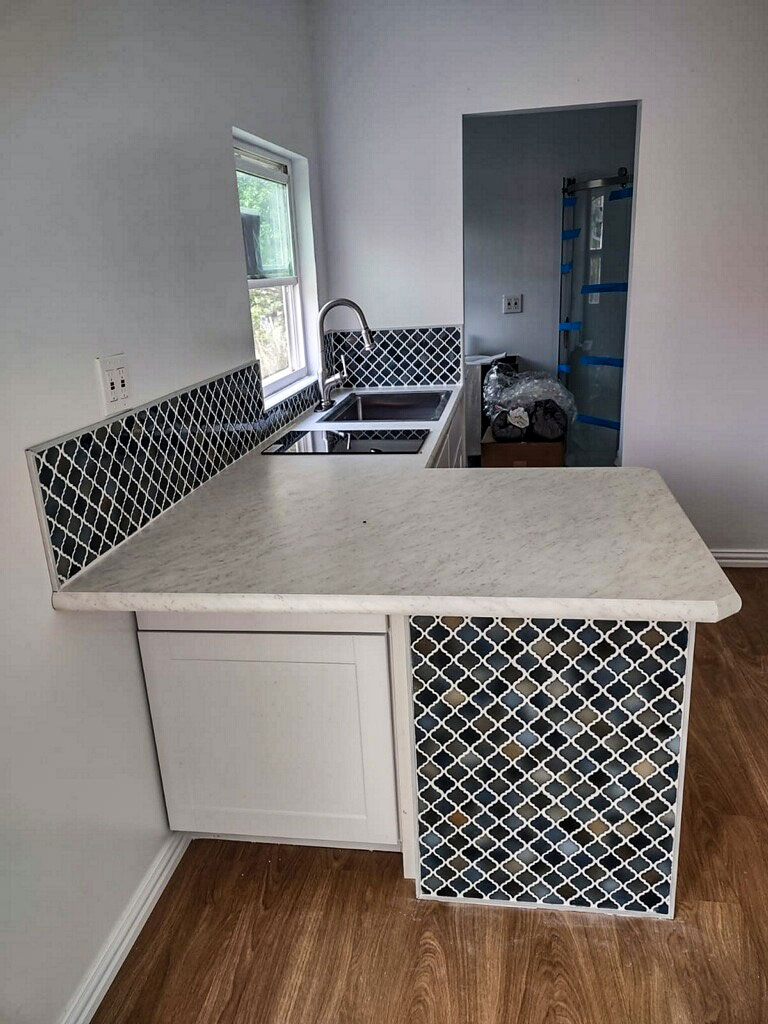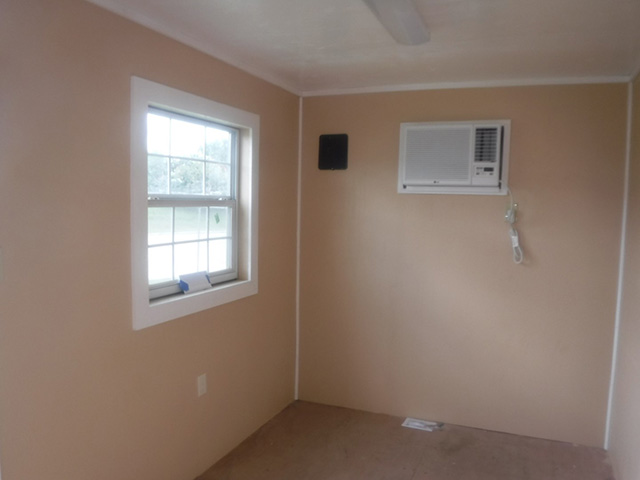
Shipping Container Homes
Shipping container homes have been growing in popularity in recent years. They are a great option for those looking for a tiny home that is affordable, sustainable, and durable. Here at Advanced Container Co., we can turn an empty, steel shipping container into your next home, living quarters for employees, or vacation getaway.
Our used and new shipping containers can be made into a pool house, lake house, bunkhouse, hunting cabin, man cave, tiny home, studio, and mobile living quarters. Our fabrication department has over 40 years of experience to build the perfect living space you need.
We understand that space is limited so we strategically design our container homes to use every inch to its fullest.
We build shipping container homes that are completely customized to our customer’s specifications. To learn more about our container home mods, give us a call.
Get a Free Quote See Our Gallery
Container Home Construction
Shipping container homes are a type of modular home built from modified storage containers as the primary structure. These homes are movable and can be placed in small areas which makes them convenient. They can also be stacked or arranged in various configurations to create your desired floor plan.
Container Living vs Container Vacationing
Container living is an alternative lifestyle that comes from individuals appreciating the simplicity of downsizing. Shipping container houses are usually located in rural areas away from the hustle and bustle of city living.
A shipping container vacation getaway could be just what is needed for your next holiday. They can be placed on property and be self-sustaining.
Industrial Mobile Living Quarters
Mobile living quarters are designed with function in mind. They fit the distinct purpose of making employees comfortable while staying at the jobsite and create a safe relaxing space.
Design Ideas for Your Container Home Conversion
Below are just a few container home interior design ideas.
Light Colors: Create an illusion of space by keeping the colors light and airy. Pick light colors like off-white, light gray, greens or blues for the walls, floors, trim, and furniture.
Half Walls: One option to make a space look bigger is to add a half wall with a sliding barn door instead of a full wall with a door.
Accessories: When decorating your container home consider added a strategically placed mirror or a glass tabletop to add the illusion of depth.
Furniture: Choose furniture the fits the room size and think about adding folding or nesting tables. Furniture with exposed legs and open arms can allow light to filter through it and seem airer. A convertible couch that can turn into a bed is a good option too.
Cut the Clutter: Clutter can make a space look smaller so be intentional on how many art pieces, possessions and patterns are in the room.
Let the Sun Shine In: Natural lighting can make a small space feel bigger. Add plenty of windows or even a sky light. For privacy small windows can be placed taller on the walls. Sliding doors are also a great way to save space while letting natural light in.
Increase Your Space to the Great Outdoors: Adding a porch and decorating it provides an extra space for relaxation or entertaining. It can also serve as an extension of the living area and provide additional square footage. Porches can be added to the roof or attached to the front, back, or side of a container home, and they can be either open or enclosed.
Keep the Metal: When stacking containers to build a two-story, larger space consider leaving the exposed raw metal ceiling or painting it a light color. This will save money and create a one-of-a-kind space.
Custom Container Home Modifications
Container Homes; Made to Order
There are endless modifications of shipping containers for residential, recreational, and industrial use. To turn a storage container into a dwelling, Advanced Container can cut and convert the storage container into entryways, doors, and windows. The amenities are where the cost to build a container home start to vary. The container will need insulation, flooring, cabinetry, and all the amenities of a tiny home.
Standard Container Home Features
Exterior Features Available
- Exterior doors, windows, and skylights
- Hideaway entrance with a entry door
- Low E insulated tinted windows
- Roofing
- Lighting: flood lights / LED Lighting
- Doors: personal doors, sliding glass doors, and more
- Top deck with railing
- Wood / aluminum accents on exterior walls
- Decking
Interior Features Available
- Flooring: wood tile, carpet, and more
- Electrical
- Plumbing (including sinks, showers, and bathtubs)
- Framing, insulation, and walls
- Walls (un-textured, textured, painted any color)
- Doors
- Cabinets and closets
- Floating shelving
- HVAC systems
- Kitchen and bathroom finishes
- Electric tankless water heater
- Washer and dryer connections
Pick the Perfect Size
Traditional Sizes
The modular shape of storage containers is ideal as a primary residence or a secondary dwelling. For smaller spaces like a man cave the 20-ft container can work. This gives you 160 square feet of floor space for a storage container home. For more space, our 40-ft containers have double the square feet of floor space at 320 square feet.
High Cube Sizes
A traditional storage container is 8ft wide and 8.5-ft tall, with a 6.5-ft door opening on one end. A high cube container is 9.5-ft tall, giving you an extra foot of headroom. That may not seem like much, but it can make a big difference when you’re standing in a room or moving around furniture. Everyone loves tall ceilings, and it really does make the space feel bigger. Our high cube options are available in 20-ft-HC and 40-ft-HC.
What are the Pros and Cons of Shipping Container Homes?
Pros
Custom container homes are trendy, cheap, and sustainable. Read below to see more pros:
Affordable: With rising lumber costs container homes are more affordable than traditional homes and they offer more flexibility in where they are located.
Stackable: One interesting feature of shipping container homes is that they can be stacked on top of one another to create a second story, providing homeowners with more living space. Additionally, they can be stacked in different configurations to create shaded covered areas, making them ideal for outdoor living spaces.
Easily transported and easily set up or made mobile.
Environmentally friendly: A storage container home is upcycled, meaning it’s a repurposed product from the shipping industry.
Timeframe: Building a container home is faster than a conventional home. There is also an advantage because they are built indoors in our fabrication shop.
Built to last: These cargo containers are built to withstand the harshest weather conditions, so they are structurally sound– including wind and watertight.
More states are allowing shipping container homes to be permitted on their land including: Texas, California, Tennessee, Louisiana, Missouri, Oregon, and Alaska.
Cons
Below are a few precautions to consider when using a container as the foundation for your tiny home.
Structural issues: Shipping containers are very strong, especially at the corners. As conversions are made to the structure, it is important to have the correct reinforcements, so the corrugated steel walls stay strong. This is why it is important to pick the best container modification specialist like Advanced Container Co.
Safety concerns: When using a repurposed container to build a home be cautious. Sometimes you don’t know what it has been through, where it has been, or what was shipped in it. Shipments could be anything from harmless personal items to hazardous industrial materials. Plus, the industrial paints and finishes on containers are intended for shipping across the ocean, so they could contain lead and toxic pesticides. That’s why we recommend starting with a new, 1 trip container.
Rust: Because steel containers are made of metal, rust is an obvious concern. When they are exposed to harsh environments for a long period of time they will rust if precautions aren’t taken. One of the worst locations can be the beach. There are preventative measures to inhibit rust, you can learn more in this container maintenance blog post.
Contact Us to Build Your Container Home
If you are interested in learning more about converting a shipping container into a house or cabin, our team of experts is available to answer any questions you may have. We can provide information on the cost, time frame, and necessary modifications for your specific project. Give us a call today!
VIEW MORE MODIFICATION OPTIONS

